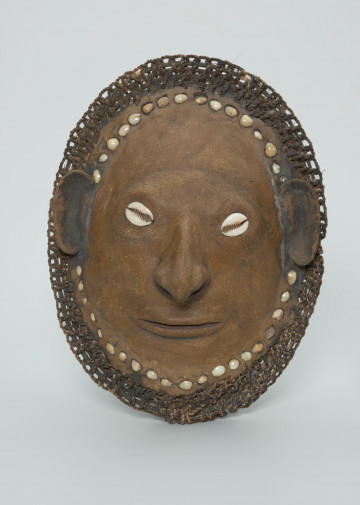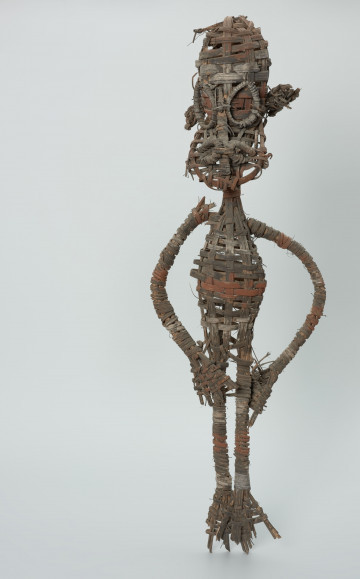
Tortoise-shell mask of ancestor
około 1980 — 1985
National Museum in Szczecin
Part of the collection: Art of Papua New Guinea
The slit drum is a percussion instrument from the idiophone group. According to the Sachs-Hornbostel classification, developed by ethnomusicologists Erich Moritz von Hornbostel and Curt Sachs, slit drums are classified as directly struck idiophones. The presented drum comes from the Admiralty Islands belonging to Papua New Guinea. Its body was made from a single piece of hardwood (perhaps a jackfruit trunk), along which a slit was cut, and the centre hollowed out with long chisels. The drums, traditionally made and used by men, were decorated with ornamentation related to ancestor worship, including motifs of mythical animals such as crocodiles, praying mantises and birds. In this case, two opposing handles are topped with carved crocodile mouths. The slit of the drum is supposed to represent the mouth of an ancestor who speaks when struck. It was played during significant ceremonies such as initiation and funerals. Due to its loud sound, the drum also had a signalling function as it was used to transmit messages over long distances. The range of the message depended on weather conditions, terrain, acoustic interference, and the instrument's quality. In favourable circumstances, the sound could be heard at a distance of several to several dozen kilometres. The slit drum comes from the collection gathered at the turn of the 19th/20th century by George Buschan and members of the Society for the Knowledge of Peoples and the Earth. George Buchan was a German doctor and an avid lover of exotics. He was an essential figure for the Szczecin's Museum and non-European collecting. In 1912, he donated his entire collection to the Szczecin City Museum (Museum der Stadt Stettin). After the war, the City Museum (now the National Museum in Szczecin) took over the remains of the collections of the former German museums, including Georg Buchan's collection. In 1951, part of the objects from the oceanic collection was transferred to the collection of the Museum of Folk Cultures in Młociny, later the State Ethnographic Museum in Warsaw. In Szczecin, 57 objects from the post-war collection remain.
Katarzyna Findlik-Gawron
Author / creator
Dimensions
cały obiekt: height: 33 cm, width: 114,5 cm
Object type
cult object
Creation time / dating
Creation / finding place
Identification number
Location / status

około 1980 — 1985
National Museum in Szczecin

1951 — 1995
National Museum in Szczecin

1951 — 1995
National Museum in Szczecin
DISCOVER this TOPIC
Museum of King Jan III's Palace at Wilanów
DISCOVER this PATH
Educational path